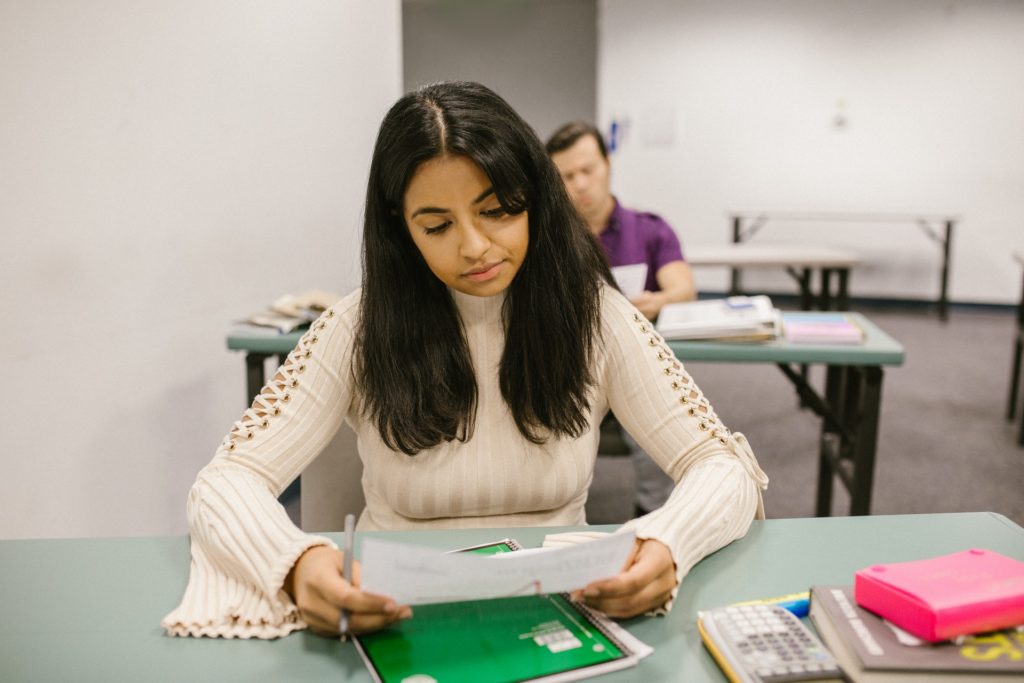Why would teachers ever be better off giving students a bad example? When searching for examples for papers, projects, or other long term assignments, teachers often seek out or even create their own perfect version of the assignment. There is a good reason for this as giving students a good example is key for helping the visual systems of their brains to see what is expected and notice when their work doesn’t look right. Seeing a good example also allows them to learn from the assignment itself as looking over and discussing a high level exemplar can be a great class activity.
Recent research into brain based learning has put into question whether this is enough, however. Rather than only giving students good examples, this research suggests that students need a variety of types of examples to learn how to recognize the good and avoid common errors. While it may sound strange to be giving students a bad example to look at, it will help their brain notice errors better since they’ve seen them before. Additionally, there is an easy trick that every teacher can use to have a constant large supply of examples of varying levels for every project they do all year.
New Research on Guided Learning
A study published in Nature was conducted on mice to test how various sensory contexts affected their ability to learn. (Chung et al.)The researchers were particularly interested in an area of the brain called the hippocampus, which is an important brain region in deciding which information gets tagged for long term memory.
One part of the hippocampus, called the dentate gyrus is the first point in the brain where all sensory information merges together and begins creating mental representations. Having strong connections between this part of the hippocampus and other areas of the brain’s cortex has been shown to be key in “learning how to learn” which in this case was defined as the brain efficiently being able to process information, ignore irrelevant information, and recognize important information that must be acted upon.
The researchers used mice for this experiment and gave some of the mice a specialized training for this area of the brain called CCT (Cognitive Control Training). In this training, the mice were put into an arena that was slowly rotating. Some areas of the arena were rigged to give a shock to the mouse, but the researchers gave the mice visual signals to learn, showing them where the shock would happen so they could learn to avoid it. The mice were given a two hour session of training where they learned to ignore the irrelevant rotation and focus on the correct visual queues to avoid the shock.
The study showed that even with just a two hour training session, there were significant increases in the connections from this key area as well but this wasn’t all that the researchers found. They noted that “CCT facilitated learning new tasks in novel environments for several weeks, relative to unconditioned controls…”
This shows that this learning wasn’t just useful for the specific training task they underwent, but this learning also transferred to other new challenges as well. Also encouraging is the fact that this effect on the brain was a “change that persists for months.” (Chung et al.) Because they had seen what was irrelevant before and knew what to avoid in the previous experiments, they were better prepared to perform further experiments improving more quickly due to their understanding of what mistakes they had made before.

The Importance of Giving Students Multiple Examples
Helping students to notice what not to do is often just as important as helping them see what they are supposed to do. When only giving a good example, this leaves room for students to miss important elements that gave it high marks.
While the students may recognize that it is high level work, many will struggle when asked to describe what makes the work score highly. Most teachers already discuss their examples with students to help them understand why the example received a high grade, but with this research, teachers should consider spending even more time working with students on examples.
Helping students learn to sift through work and learn to identify what makes good work good and bad work bad will help their brains learn to process and recognize quality in their own work as well as be better consumers in the real world who aren’t swayed by low quality content.
While it may sound daunting to create so many examples, teachers don’t actually need to do any extra work for this. They can collect past student examples from previous classes, remove the names, and have an ever growing supply of examples of all levels that show genuine common errors in students in their age group. Using real examples not only makes it easier on the teacher to not have to craft everything, but can be used as a mindful teaching practice to note errors from previous years and ensure more time is spent with students to avoid those same errors. Using real data to improve student outcomes isn’t just efficient, but also best practice.
One practical application of this research would be to have a lesson plan based entirely on looking through example work and slowly unpacking the qualities of each. Rather than only giving students a perfect model, give students a range of papers/projects that scored all along the grade continuum.
Students can then be tasked with attempting to grade the assignments themselves. Using the rubric and/or instruction sheet they received, students can work alone or in pairs to decide what grade they think the teacher would give such work. This will stimulate critical thinking not only in what makes good work good, but what are some of the most common errors to avoid. Afterwards, the teacher can reveal the actual grades and discussion can continue as a whole class or back in small groups as students match their expectations with the actual grades and see how close they got to the mark.
For example, when only using high level examples, a student might recognize that a literary analysis essay is high quality work due to the vocabulary and register the work is written in and try to emulate how it sounds, but if the student hasn’t remembered that one of the key elements of having proper register is not using personal pronouns, they may still include them without realizing.
Instead, if students are given papers with and without personal pronouns, they’ll be able to notice that this is one of the key differences between the essays and when discussing why that example lost points, the discussion will naturally point out the use of personal pronouns. This not only helps students see what their paper shouldn’t look like generally, but is better at highlighting key mistakes students should avoid. Giving students a bad example helps prime their brain to know what poor work looks like and know better how to avoid it.
It is also beneficial to do this with example papers rather than the students own work as it is easier for students to be critical of anonymous papers than it is for them to critique their own work, especially when it might mean they have to erase a lot of what they have already written. This class activity can be done right when assigning a new project or paper, once students have begun their research and begin putting together what they will turn in, or as a way to help students before doing a peer or self review of their own work. All of these timings have their own benefits, and so it will be up to the teacher’s expertise to see what their specific students will need during a specific assignment.
Doing this grading game before starting helps remove misconceptions early, gives students a clear goal to shoot for as they begin pulling information together, and can solve issues before they even have the chance to arise in student work. Doing it too early, especially with particularly long projects, leaves far too much time for students to forget the examples though, so it is important to keep in mind how many days or weeks there may be between assigning the work and students actually being ready for the information. Waiting a while for students to get their footing in the subject or topic they’ll be working with is also a good approach as students can have a freer research session before looking at what they will need to put together when they actually begin working in earnest.
This too can sometimes be a bit early however, as starting a project or paper and finishing it often leaves plenty of time to forget as well as students not being able to immediately transfer their learning to their own work. If teachers wait until students have a draft completed, students can not only find the errors in the examples, but then directly move over to their own drafts and have a much clearer idea of what changes need to be made.
It really depends on the type and length of the assignment as well as the personality of the students that determines when the best time is to look at examples. The teacher will know what will be motivating or demotivating for their own students and can decide accordingly. There are also many projects and papers in a year, so teachers can test different placements to see what helps students the most.

In the real world, students will encounter a lot more low quality work than they will masterpieces. It is so important that teachers not only focus on looking at good work, but help students to recognize what isn’t going to be helpful for them as well. In the modern world, people are bombarded with countless internet sites, innumerable news articles, and millions of hours of mindless entertainment. Students who have learned to recognize not only the good, but also to avoid the bad will be better prepared for a world where everyone can be a content creator.
If only two hours can make a difference in helping to wire the brain and learn new patterns, then teachers, who have their students from much more than that over the course of the year, can take heart that the time they spend with their students is making a real physical difference in their students. Though it can sometimes be hard to see in the short term, teachers will start to notice an upward trend each year as they gather even better examples that highlight not just what students should emulate, but also what they should avoid doing. Giving students a bad example gives them a good example of what not to do.
Want more like this? Make Lab to Class a part of your weekly professional development schedule by subscribing to updates below.
References
Chung, Ain, et al. “Cognitive Control Persistently Enhances Hippocampal Information Processing.” Nature, 2021, https://doi.org/10.1038/s41586-021-04070-5.



